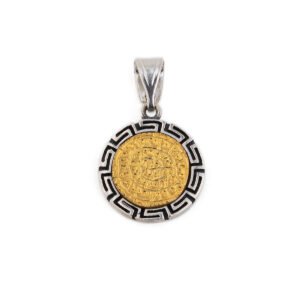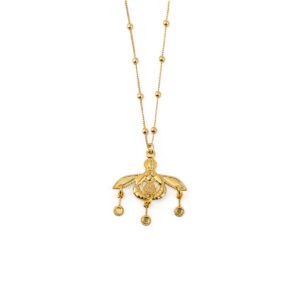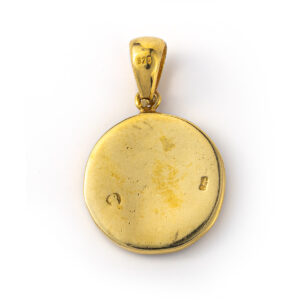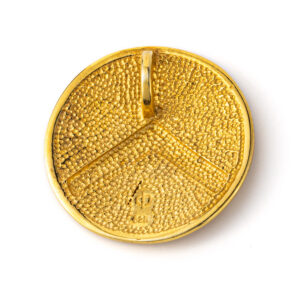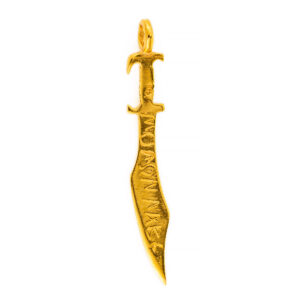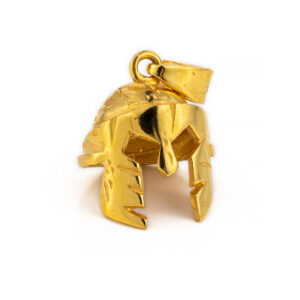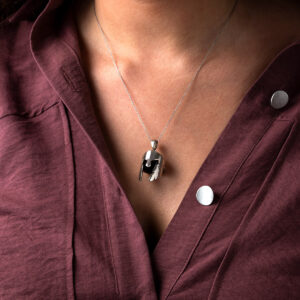Pendants
Phaistos Disc and Minoan Bees Pendant – 925 Sterling Silver and Gold Plated
Made of 925° sterling silver and gold plated.
Handmade item. Explore Phaistos Disc Collection
The Phaistos Disc is a disk of fired clay from the Minoan palace of Phaistos on the island of Crete. Now, the island of Crete is part of modern Greece. The disc was discovered in 1908 by the Italian archaeologist Luigi Pernier in the Minoan palace site of Phaistos. While it is not clear that it is a script, most attempted decipherments assume that it is; most additionally assume a syllabary, others an alphabet or logography or a calendar. The Malia honeybee pendant was discovered at Chryssolakkos, of the Minoan Palace of Malia on the island of Crete, and is thought to date to c.1800 BC. The named Chryssolakkos means the “pit of gold” because of the precious objects that the farmers used to find there. The Minoan Palace is situated 3 km east of Malia town and is the third most significant known Minoan Palace after Knossos and Phaistos. This pendant is in the shape of two bees, or wasps, storing away a drop of honey in a comb and is one of the most famous exhibits in the Heraklion Museum.
Minoan Bees Necklace – 925 Sterling Silver Gold Plated
Made of sterling silver 925° and gold plated.
Handmade in Greece.
Explore Heritage Collection
History
The Malia honeybee pendant was discovered at Chryssolakkos, of the Minoan Palace of Malia on the island of Crete, and is thought to date to c.1800 BC. The named Chryssolakkos means the “pit of gold” because of the precious objects that the farmers used to find there. The Minoan Palace is situated 3 km east of Malia town and is the third most significant known Minoan Palace after Knossos and Phaistos. This pendant is in the shape of two bees, or wasps, storing away a drop of honey in a comb and is one of the most famous exhibits in the Heraklion Museum.
Minoan Bees Necklace – 925 Sterling Silver and Gold Plated
Made of sterling silver 925° and gold plated.
Handmade in Greece.
Explore Heritage Collection
History
The Malia honeybee pendant was discovered at Chryssolakkos, of the Minoan Palace of Malia on the island of Crete, and is thought to date to c.1800 BC. The named Chryssolakkos means the “pit of gold” because of the precious objects that the farmers used to find there. The Minoan Palace is situated 3 km east of Malia town and is the third most significant known Minoan Palace after Knossos and Phaistos. This pendant is in the shape of two bees, or wasps, storing away a drop of honey in a comb and is one of the most famous exhibits in the Heraklion Museum.
Minoan Bees Pendant – Sterling Silver and Gold Plated
Made of sterling silver 925° and gold plated.
Handmade in Greece.
Explore Heritage Collection
The chain shown is not included.
History
The Malia honeybee pendant was discovered at Chryssolakkos, of the Minoan Palace of Malia on the island of Crete, and is thought to date to c.1800 BC. The named Chryssolakkos means the “pit of gold” because of the precious objects that the farmers used to find there. The Minoan Palace is situated 3 km east of Malia town and is the third most significant known Minoan Palace after Knossos and Phaistos. This pendant is in the shape of two bees, or wasps, storing away a drop of honey in a comb and is one of the most famous exhibits in the Heraklion Museum.
Spartan Shield Pendant – Sterling Silver and Gold Plated
This pendant represents the shield of the Spartans.
Made in 925⁰ sterling silver and gold plated.
Handmade pendant.
The letter lambda (Λ), standing for Laconia (the administrative capital of Sparta) or Lacedaemon (ancient name for the city of Sparta), which was painted on the Spartans’ shields, was first adopted in the 420s BC, and quickly became widely known Spartan symbol. Military families passed on their shields to each generation as family heirlooms.
Spartan Shield Pendant – Sterling Silver & Gold Plated
This pendant represents the shield of the Spartans.
Made in 925⁰ sterling silver and gold plated.
Handmade pendant.
The letter lambda (Λ), standing for Laconia (the administrative capital of Sparta) or Lacedaemon (ancient name for the city of Sparta), which was painted on the Spartans’ shields, was first adopted in the 420s BC, and quickly became widely known Spartan symbol. Military families passed on their shields to each generation as family heirlooms.
Spartan Shield Pendant
The 300 Spartans Shield.
This pendant represents the shield of Leonidas. Leonidas was a warrior king of the Greek city-state of Sparta. Arguably, one of the greatest heroes in the history of ancient Greece.
In 480 B.C Leonidas led an army of 6,000 to 7,000 Greeks from many city-states, including 300 Spartans, who fought the invading Persian army at the pass of Thermopylae. Leonidas of Sparta blocked the only road through which the massive army of Xerxes could pass. The Persians succeeded in defeating the Greeks but sustained heavy losses. A local resident named Ephialtes led the Persian general by a mountain track to the rear of the Greeks. King Leonidas sent away all the Greek troops and stayed behind with 300 Spartans, 400 Thebans, and 700 Thespian volunteers who refused to leave. They were all killed on the battlefield, protecting their homeland.
Made in 925⁰ sterling silver and gold plated.
Handmade pendant.
Leonidas Spartan Sword Pendant
Leonidas Spartan Sword Pendant
Handmade pendant sword in 925⁰ sterling silver and gold plated.
On the reverse side is the inscription “μολών λαβέ” which means “come to get”. This phrase was the answer to Xerxes when he asked him to hand over the arms of the defending Greeks to the Thermopylae. Leonidas was a warrior king of the Greek city-state of Sparta. Arguably, one of the greatest heroes in the history of ancient Greece. In 480 B.C Leonidas led an army of 6,000 to 7,000 Greeks from many city-states, including 300 Spartans, who fought the invading Persian army at the pass of Thermopylae. Leonidas of Sparta blocked the only road through which the massive army of Xerxes could pass. The Persians succeeded in defeating the Greeks but sustained heavy losses. A local resident named Ephialtes led the Persian general by a mountain track to the rear of the Greeks. King Leonidas sent away all the Greek troops and stayed behind with 300 Spartans, 400 Thebans, and 700 Thespian volunteers who refused to leave. They were all killed on the battlefield, protecting their homeland.
Spartan Helmet Pendant – Sterling Silver & gold plated
Replica of the helmet of Spartan King Leonidas.
Leonidas was a warrior king of the Greek city-state of Sparta. In 480 B.C Leonidas led an army of 6,000 to 7,000 Greeks from many city-states, including 300 Spartans, fought the invading Persian army at the pass of Thermopylae. Leonidas of Sparta blocked the only road through which the massive army of Xerxes could pass. The Persians succeeded in defeating the Greeks but sustained heavy losses. A local resident named Ephialtes led the Persian general by a mountain track to the rear of the Greeks. King Leonidas sent away all the Greek troops and stayed behind with 300 Spartans, 400 Thebans, and 700 Thespian volunteers who refused to leave. They were all killed in the battlefield, protecting their homeland.
Handmade pendant made from 925⁰ sterling silver and gold plated.

